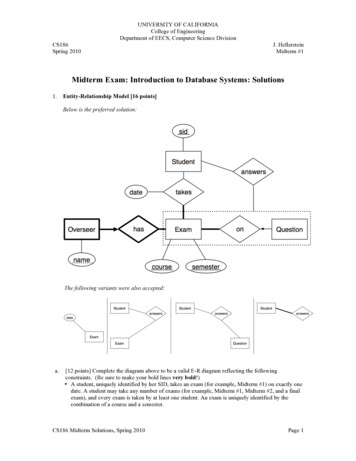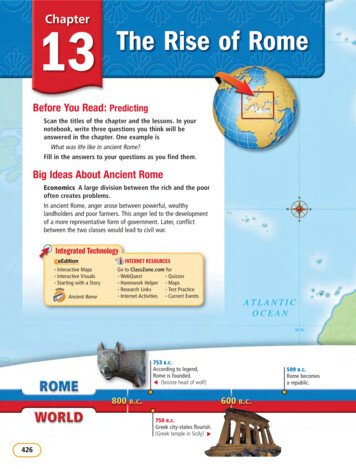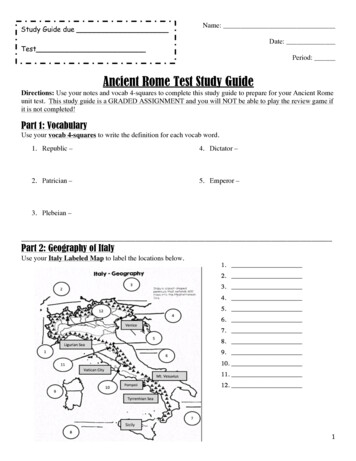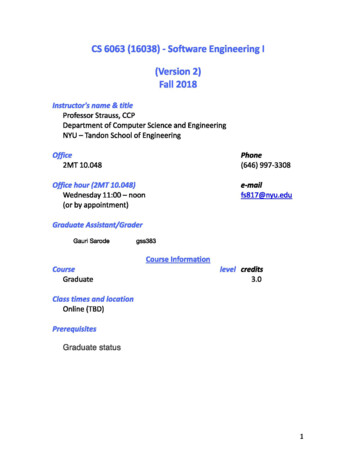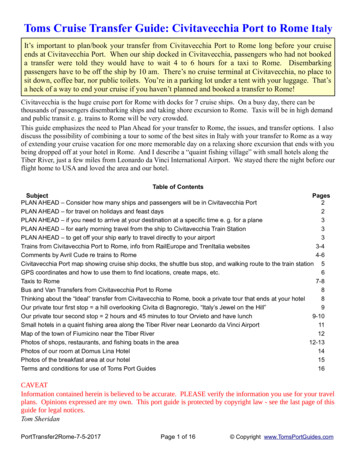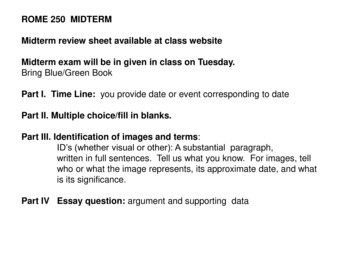
Transcription
ROME 250 MIDTERMMidterm review sheet available at class websiteMidterm exam will be in given in class on Tuesday.Bring Blue/Green BookPart I. Time Line: you provide date or event corresponding to datePart II. Multiple choice/fill in blanks.Part III. Identification of images and terms:ID’s (whether visual or other): A substantial paragraph,written in full sentences. Tell us what you know. For images, tellwho or what the image represents, its approximate date, and whatis its significance.Part IV Essay question: argument and supporting data
Spirituality in the Roman World***The Christianization of the Roman Empire and theRomanization of Christianity
Religions and Philosophies of Roman Empire Roman religion: polytheistic, anthropomorphic,inclusive [respect for traditions]– Religious syncretism [mixing and adaptation](interpretatio romana)– Household gods [lares and penates], major gods--propitiatory [gain the good will]--proper ritual toensure approval and guarantee pax deorum--pietas: recognition, respect, reverence--ritual: temples, prayer, sacrifice, divination(augury, haruspicy: the interpretation of divinesigns)
Marcus Aureliussacrificing in frontof Capitolinetemple176-180 CE
State Religion: worship of traditional Roman state godsand civic imperial cult [deus and divus]--emperors were comites [companions] to the gods--for bad emperors damnatio memoriae--Diocletian: Dominate vs. Principate--Test: sacrifice to cult indicating loyalty to Rome--Monotheistic Christians refused to sacrifice
Apotheosis of Antoninus Pius and Faustina, 161 CE
Greek Philosophies and the Moral Life appropriated by Romans for ethical issues: i.e., the best wayto live one’s life: pursuit of wisdom and peace of mind --STOICISM:– divine reason (logos): rules over the universe– determinist: you cannot control what happens but youcan control your reaction to it– self-discipline: freedom from passions [apatheia]– universal brotherhood: sense of duty and public lifeMarcus Aurelius, Meditations (170s CE)
Marcus Aurelius—Meditations (170s CE) Take away your opinion of something and you will takeaway your complaint. Take away the complaint, “I havebeen harmed,” and the harm is taken away. --Keep yourself simple, good, pure, serious, free fromaffectation, a friend of justice, a worshipper of the gods,kind, affectionate, strenuous in all proper acts.Reverence the gods, and help men. Life is short.
--Epicureanism: atomic materialism, no afterlife, freedom fromfear Lucretius, De rerum natura (c. 60 BCE) --Neoplatonism: ideal forms vs. imperfect reality, the soullongs to return to the universal good evil (excessive attachment to material world) as the absence ofgood
Greek and Eastern mystery cults--Initiation cults: provide a sense of community; fertility cultsthat often emphasize afterlife, individual salvation Cult of Dionysus-Bacchus (god of wine): bacchanalia
Egyptian cult of Isis: mother goddess: son Horus,husband Osiris-- fertility cult associated with flooding of Nile river;particularly popular with women
Persian cult of Mithras: god of light and truth andcontracts-- male cult of soldiers and loyalty, bull sacrificeand baptism in Mithraeum
Religion / Spirtuality in the Roman World Household gods (ancestor reverence)Major “Temple” godsState religionImperial cultGreek Philosophies to live a wise lifeGreco/Eastern mystery cults, sense of communion
Judeo-Christian religionsJudaism: monotheistic, ethical andapocalyptic [coming of a Messiah]--sacred scriptures: “people of the book”--spreads widely: Hellenistic period, Romandiaspora of Jews in 70 and 135 AD--Godfearers
Christianity: offshoot of monotheistic Judaism; becomesprogressively more distinct: universal and egalitarian--sacred scriptures, rule of faith, belief in salvation,apocalyptic, cult of martyrdom, conversion--sacraments: baptism and communion--suspect for Romans--fairly intolerant of other religions and of deviances(heresy) from Christian orthodoxy [“right thinking”]
Time table of rise of Christianity in RomanEmpire--0-33 AD Life and crucifixion of Christ-- 34-64 Proselytizing by Sts. Peter and Paul--70-100 AD circa: Gospels--1st-3rd centuries: slow growth, periods ofpersecution--303—Great persecution under Diocletian--312—Constantine: Battle of Milvian Bridge,vision of the cross, “in hoc signo vinces”--313—Edict of Milan: Christianity legalizedunder Constantine--325 Council of Nicea under Constantine:Arianism declared a heresy
Final triumph of Christianityevents leading to City of God382: Removal of pagan statue of Victory fromSenate House in Rome390: Emperor Theodosius outlaws paganism410: Sack of Rome by Alaric the Visigoth--pagan accusations against Christianity asresponsible for the sack
St. Augustine (354-430) and the Christian World View Autobiography: Confessions Mother Monica (a Christian) Carthage-Rome-Milan (conversion by St. Ambrose) Bishop of Hippo Refutation of 4th-5th century heresies; establishes Church doctrine Manicheaism: problem of evil in monotheism:explanation via dualism: good God vs. evil GodProblem: omnipotence of God vs. goodness of GodAugustine: theory of evil as absence of good Pelagianism: 4th century Roman priest, Pelagius Salvation through effort, good works morality Augustine: original sin as totally corrupting, need grace
City of God, De civitate dei contra paganos, 413-426 Christian versus Roman explanations of Sack of Rome:– Roman: abandonment of worship of official Roman gods Augustine: Rome as the “city of man”:impermanent state as punishment for original sin, man is fallenheavenly City of God versus earthly city (Rome)but Roman Empire divinely ordained to spread ChristianityDivine Providence guides history towards last days New values:– Roman pride vs. Christian humility dependent on divine grace– Suffering visited on good and bad alike– Chastity, rape, Lucretia
The Christianization of the Roman Empire and the Romanization of Christianity1) Representations of Constantine
NummusofConstantine306-307 CE
MedallionofConstantine315 CE
Constantine with Sun God [Sol Invictus], c. 317 TrierImp Constantinus AugSoli Invicto Comiti
Seated statue of Constantine, 315
Jupiter, late 1st century CEAugustus as Jupiter 45-50 CE
Constantine (dominate)Trajan (principate)
Arch of Constantine, 312-315 CE
Arch of Constantine—the Inscription To the great Emperor Caesar Flavius Constantine, Maximus, Pius, Felix,Augustus: The Senate and the People of Rome, By means of the inspiration of the Divine Mind and his own greatness, Have dedicated this exceptional arch to the triumphs of, He who used his army to save the state by the just force of arms from a tyrant on the one hand and every kind of factionalism on the other.
Arch of Constantine in relation to colossal statue of Sun God
Constantine entering Rome with Sun god above
Arch of Constantine, spolia
Marcus Aurelius / Constantine: addressing troops, sacrificing
Hadrian / Constantine: boar hunting, sacrificing to ApolloConstantine addressing Romans
Ara Pacis, Procession of Augustus’ family
The Christianization of the Roman Empire and the Romanization of Christianity2) Representations of Christ
Rome, Via Appia Antica
Catacombs of St. Callixtusloculi and cubicula
ICHTHUSfishIesus ChristosTheou Huios SoterJesus Christ, Son ofGod the Savior
Catacomb of Peter and Marcellinus, Christ and Story of Jonah
Christ as Good Shepherd
Christ asOrpheus
Christ as Sol Invictus, Tombof the Julii, 3rd century CE.Clement of Alexandria: “For theSun of Righteousness, who drivesHis chariot over all, pervadesequally all humanity, like HisFather, who makes His son to riseon all men” (Exhortation to theHeathen 11).
Christ as teacher, Catacombs of Domitilla, 4th century
Sarcophagus of Junius Bassus, 359 CE
Apse mosaic, Santa Pudenziana c. 410 CE. Hymn of Prudentius:All mankind came under the rule of the city of Rome, to see the entire worldlinked by a common bond in the name of Christ. Grant then, Christ, to your city, acapital Christian like the rest of the world. Peter and Paul shall drive out Jupiter.
Santa Maria Maggiore, 430 c
Santa Maria Maggiore: triumphal arch
Dedication: what and who do we see? Signs of legitimacy
Santa Maria Maggiore: triumphal arch
Santa Maria MaggioreAnnunciation and Adoration of Three Kings
Marcus Aurelius—Meditations (170s CE) Take away your opinion of something and you will take away your complaint. Take away the complaint, "I have been harmed," and the harm is taken away. --Keep yourself simple, good, pure, serious, free from affectation, a friend of justice, a worshipper of the gods,
